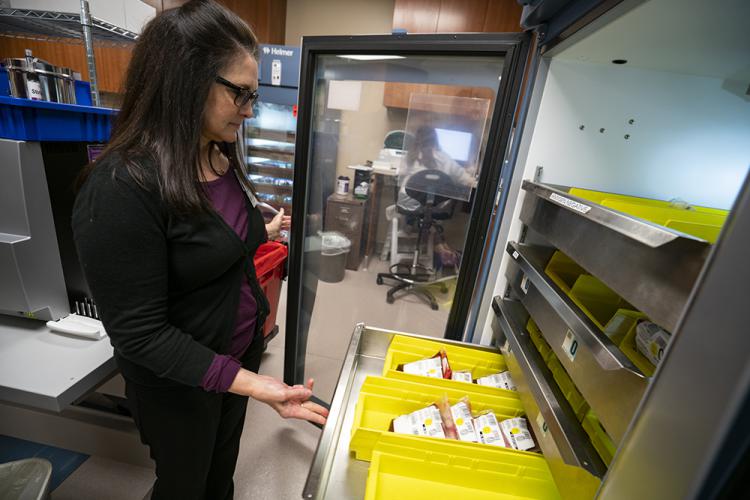
There are some things people just can’t do without. One of those things is blood.
Patients count on JPS Health Network to have an ample supply at the ready if they have a traumatic accident, if they require transfusions during cancer treatments or if they need it during surgery. Having enough of the right type of blood products—whole blood, platelets and plasma—on hand could be the key to saving a life. So, the supply is carefully managed by experts who make sure the health network is always prepared for any emergency that arises.
“We have a team of 18 people in the blood bank who are constantly monitoring our blood supply and making sure it’s ready when it’s needed,” said Marie Becerra, manager of Transfusion Services at JPS. “It keeps us very busy.”
Keeping just the right amount and types of blood products on hand—and making sure they get where they need to be in a timely manner—is a complicated process. According to the American Heart Association, whole blood is good for only about 42 days from the time it is donated. So it’s important to keep a careful watch on the inventory to make sure blood is used in the most timely and efficient way possible.
While having too little available could have tragic results, hoarding blood could cause the valuable resource to go to waste. So, JPS blood bank management works through partner Carter BloodCare to keep track of how much of each type of blood area hospitals have on hand. If one hospital runs low on a certain type, there is a plan in place to get some from another healthcare provider’s reserves.
So what happens when there is suddenly a call for blood?
In the blood bank at JPS, tucked anonymously away in a hallway behind a locked door and a walk-up window, there is a wall of refrigerators with glass doors, similar to what you might see when you stop in at your local convenience mart. Instead of being stocked with cartons of milk, bottles of tea and an endless variety of soda, the shelves in the blood bank contain neatly labeled plastic bags of blood, sorted by type and stored in yellow bins.
Around the brightly lit and spotlessly clean room are work stations with microscopes and other instruments used to allow team members to test and type blood.
When an emergency case is inbound to JPS on a helicopter or in an ambulance, blood bank team members head for a special section of their refrigerator. There they find trauma buckets, plastic pails kept at the ready 24 hours a day, seven days week so they can be rushed over to the trauma bay for patients who arrive with a serious injury. They contain four units of red blood cells and two units of plasma. There are two types of trauma buckets, ones supplied with O Negative blood and ones supplied with O Positive.
Type O is known as the universal blood type because it will be accepted by not only Type O patients, but people of other blood types, too. That compatibility is important in a trauma case because there often isn’t time to test a patient’s blood for type before the first units of stored blood are transfused. Becerra said the blood products in the trauma bucket will usually sustain the patient until their blood can be tested, then they’re switched to their natural blood type to preserve the valuable Type O blood.
According to Dr. Rajesh Gandhi, it’s not unusual to use 10-20 units of blood in just one trauma case. Sometimes that number can rocket up to 90 or 100 units in the worst of circumstances, claiming 10 percent of the blood supply available at any given time in the Dallas-Fort Worth Metroplex.
So what happens when a lot of blood is needed quickly? A Massive Transfusion Protocol is put into action.
Blood is delivered to the patient in one of two types of coolers, a small one that can keep four units in the proper temperature range for up to four hours and a larger model that can maintain 11 units for as long as four hours. Both sizes of the containers have a digital timer attached to the front that count down how long the blood can be kept outside of the blood bank before it must be used or returned to refrigeration.
While JPS, the only Level I Trauma Center in Tarrant County, requires a lot of blood to help patients who arrive by helicopter and ambulance, the blood supply isn’t a one-way relationship. While they use blood in their work, health network team members are some of the most loyal blood donors in the community, replenishing the supply at every opportunity.
Judy Smith, Donor Recruitment Specialist with Carter BloodCare, said 41 people signed up to donate at the health network’s latest blood drive January 11, and 38 of them were able to successfully give blood.
“My goodness, what a great blood drive!” Smith said. “We are so grateful to the good people at JPS for their generous support. Of those 38 folks, 6 donated double red cells resulting in 12 units of red cells. We have since separated the 32 units of whole blood into red cells, plasma and platelets. So, that one drive has resulted in a total of 108 lifesaving components of blood. In addition, we had 6 first time donors and 3 donors that are O-negative! Your blood drive will touch the lives of many patients and their families. Word cannot express what this must mean to them.”
JPS will hold its next blood drive March 4 in the OPC auditorium on the third floor of the main hospital building near the red elevators.
